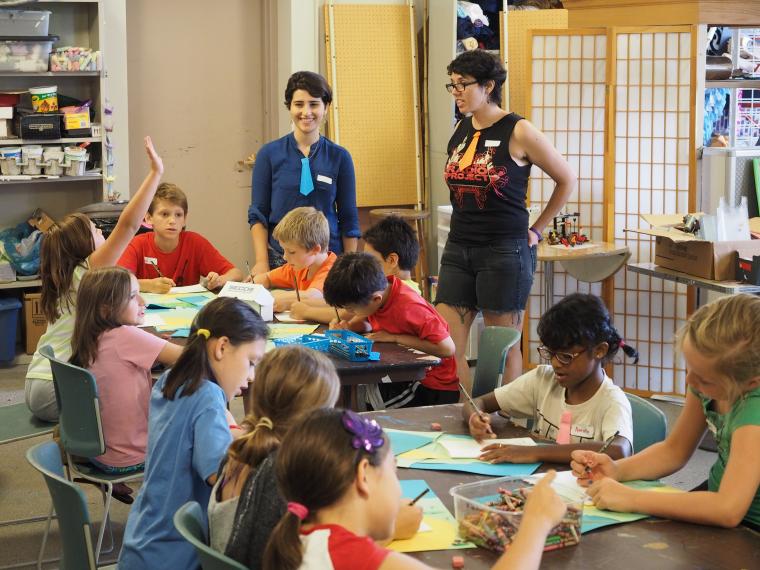Young Artists on the Rise
August 29, 2014
Rosalind Black

Photo credit: Dale Preston
“I’m not looking for perfection—what’s that?” artist and instructor Greg Cross said loudly, addressing the concerns of a roomful of chattering middle schoolers as they drew the figures of Dorothy and her friends en route to the Emerald City. “Is this good?” one student asked Cross. “I hope it isn’t scribble scrabble.” Cross looked at the four characters skipping arm in arm into the distance. “It’s great!” he replied. This was the second of three class periods, each exploring a different art medium, that the kids would attend that day at the FAVA-AMAM Kids Summer Camp, which ran from August 18 through 22.
The camp, now in its eighth year, was created by James Peake ’06, the education and outreach coordinator at the Firelands Association for the Visual Arts (FAVA). Peake joined forces with Jason Trimmer, curator of education at the Allen Memorial Art Museum (AMAM), in 2011, which has proven to be a mutually beneficial partnership. “It shows that these two organizations can collaborate and that they should collaborate,” said Trimmer. “[The museum] has the fine art base of knowledge, and [FAVA] has the studio spaces. Between our personnel and, of course, different budgets, we can do more elaborate programs than we could individually.”
Many of the students in attendance are familiar with artwork and creative processes from their school trips to the Allen, and the camp allows these 5- to 12-year-olds to practice these art techniques with their own hands. Many of the same kids return to the camp summer after summer, so Peake and Trimmer vary the art forms they offer and the instructors they hire. This summer, local and regional instructors—including Peake and the museum’s Summer Education Interns, Sara Morgan ’14, and rising senior Victoria Velasco—taught printmaking, cartooning, design, non-camera photographic processes like sun prints and collage, chalk art, and origami. Led by the stained glass artist Sheree Ferrato, the students also worked together to make a series of mosaics depicting the many aspects of Oberlin, which FAVA will permanently hang in its halls. After the three classes of the day are over, the kids have an hour of open studio where they can work on whatever they choose.
The camp unites volunteers from the college and the town, and instructors from the area to jumpstart local kids’ arts education, and provide them with new ways to express themselves and tell stories with art. The camp takes place a week before the kids return to school, which is, according to Peake, perfect timing. “Not only is it good for children to start getting back into a school-day rhythm,” Peake said, “But I’d like to think that the kids who attend our camp go on to start their school year in a creative mindset, excited at the prospect of developing new skills and learning more about their world.”
Morgan, who works with Trimmer as an intern, lauded this opportunity for the kids to let themselves go. “They all get really enthusiastic about the projects they’re doing and working with their hands,” she said. “I love seeing them so happy to create art and to work with their hands when, I think, they’re used to just playing on the computer and not working with messy paint.”
Whether credited to the summer camp, their exposure to art in school, or their natural affinity for creation, the kids soon surpassed expectations for their projects. Cross, who teaches several classes at FAVA throughout the year, and Ferrato, who has been producing art for 39 years and teaching it for 19, were impressed by their students’ enthusiasm, skill, and ingenuity. “I tell them what to do and they expand on it,” Cross said. “They’re so mature,” Ferrato agreed. Morgan, who made a postcard template to help the kids with the collage-based mail art project designed by Velasco and herself, described how some students produced something so elaborate and large that it couldn’t be mailed. “I was just happy that they were happy doing it, so I wasn’t going to force them to stop,” she said.
Regardless of whether they made postcards that can fit in a mailbox, all of the students’ work was given a proper exhibition in the Oberlin Public Library on the last day of camp. The students and counselor displayed everything they had created over the course of the week for family and friends to see. “It’s kind of surprising how much they produce over the week and how many media they work in,” said Trimmer. “It’s great to see all of the projects. Even though you have these instructions that seem very formulaic, there’s a lot of room for imagination and interpretation.”
But for the students, showing off their work and new skills isn’t even the best part. “You learn new things that you can share with more people,” said 8-year-old Zenobia, back for her fourth summer at the camp. No doubt she and her compatriots will be back next summer to absorb and pass on whatever the FAVA-AMAM camp has to offer.
You may also like…
Josh Nolan Named Vice President, General Counsel, and Secretary at Oberlin
Distinguished attorney brings extensive experience in higher education law.
Learning by Teaching: Oberlin Students Share Global Music with Young Learners
College and Conservatory students in PACE 103 prepare local children for an immersive community concert at Oberlin.
Nuiko Wadden ’02 Joins Oberlin Conservatory Faculty as Assistant Professor of Harp
The versatile musician brings extensive opera, orchestral, and contemporary music experience to her role


